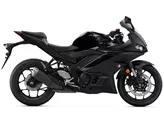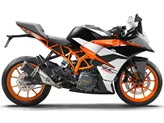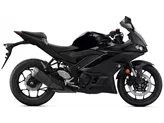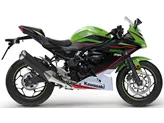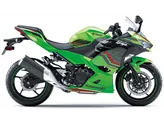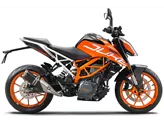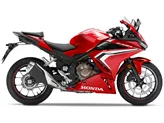Kawasaki Ninja 400 2018 vs. Kawasaki Z 300 2016

Kawasaki Ninja 400 2018

Kawasaki Z 300 2016
Overview - Kawasaki Ninja 400 2018 vs Kawasaki Z 300 2016
The Kawasaki Ninja 400 2018 and the Kawasaki Z 300 2016 are both popular models from Kawasaki, but they have some key differences in terms of technical specifications and strengths.
In terms of engine and drive train, both models have an in-line engine with a liquid cooling system. However, the Ninja 400 has a larger displacement of 399cc compared to the Z 300's 296cc. This results in the Ninja 400 having a higher engine power of 45 HP compared to the Z 300's 39 HP. The Ninja 400 also has a higher torque of 38 Nm compared to the Z 300's 27 Nm. Additionally, the Ninja 400 has a higher compression ratio of 11.5 compared to the Z 300's 10.6. Both models have 2 cylinders and 4 valves per cylinder.
In terms of chassis, both models have a steel frame. The Ninja 400 is known for its chassis suitable for sporty use, which allows for effortless handling. On the other hand, the Z 300 has favorable chassis components that contribute to its stability.

Kawasaki Ninja 400 2018
When it comes to brakes, both models have double piston front brakes with petal technology. This ensures effective braking performance for both models.
In terms of dimensions and weights, the Ninja 400 has a front tire width of 110mm and a rear tire width of 150mm, while the Z 300 has a front tire width of 110mm and a rear tire width of 140mm. Both models have a 17-inch front and rear tire diameter. The Ninja 400 has a slightly shorter wheelbase of 1370mm compared to the Z 300's 1405mm. Both models have a seat height of 785mm. The Ninja 400 has a kerb weight (with ABS) of 168kg, while the Z 300 has a kerb weight (with ABS) of 170kg. The Z 300 also has a larger fuel tank capacity of 17 liters compared to the Ninja 400's 14 liters.
Now let's move on to the strengths and weaknesses of each model. The Ninja 400 has a chassis suitable for sporty use, making it ideal for riders who enjoy a more aggressive riding style. Its low weight and effortless handling also contribute to its sporty performance. The engine of the Ninja 400 has a smooth response, providing a satisfying riding experience. The relaxed and confidence-enhancing seating position of the Ninja 400 is also worth mentioning. Additionally, the Ninja 400 features LED headlights, which enhance visibility during night rides.
On the other hand, the Z 300 has an adult look and a high-quality finish, making it an attractive option for riders who value aesthetics. Its high-revving engine delivers a thrilling riding experience. The comfortable seating position of the Z 300 ensures a pleasant ride, while its stable brake provides reliable stopping power. The Z 300 also has an easy-to-read and complete cockpit, allowing riders to easily monitor their speed and other important information. Furthermore, the Z 300 boasts a low fuel consumption, making it a cost-effective choice for riders.

Kawasaki Z 300 2016
However, both models have their weaknesses. The Ninja 400 has non-adjustable brake and clutch levers, which may not be suitable for riders who prefer customized controls. Additionally, riders over 180cm tall may experience an enormously loud wind noise with the original windshield of the Ninja 400.
On the other hand, the Z 300 has a very unobtrusive sound, which may not appeal to riders who prefer a more aggressive exhaust note. The Z 300's engine only starts when idling, which may be inconvenient for riders who prefer a more responsive engine.
In conclusion, the Kawasaki Ninja 400 2018 and the Kawasaki Z 300 2016 have their own unique strengths and weaknesses. The Ninja 400 offers a sporty performance with its chassis suitable for sporty use and low weight, while the Z 300 appeals to riders with its adult look and high-quality finish. Ultimately, the choice between these two models depends on the rider's preferences and priorities.
Technical Specifications Kawasaki Ninja 400 2018 compared to Kawasaki Z 300 2016
Pros and Cons in comparison
Pros and Cons in comparison
Kawasaki Ninja 400 2018

In summary, the Ninja 400 could be described as the perfect entry into the supersport world. You can't get more power with A2, the looks suggest much more power, the vehicle is playful to ride, is forgiving in every respect and still allows a really sporty riding style. Those who had legitimate concerns about the lack of power on the various 250 cubic machines now have no more excuses. Ninja 400, it's good to have you!
Kawasaki Z 300 2016

The cool design of the Kawasaki Z300, which is extremely similar to that of its big sister Z800, makes it a very grown-up-looking motorbike. The stable braking system and the easy-to-read cockpit with an analogue rev counter and all the necessary features fit in very well with this image. Thanks to the 170 kg ready-to-ride weight, the bike is extremely easy to handle and playful. The engine only reveals its potential in the upper rev range, but revs up willingly and makes you want to ride in a sporty manner. Only the comfort-oriented chassis cannot quite cope with radically sporty demands - but this is quite legitimate and understandable for an entry-level motorbike.
Price Comparison Avarage Market Price Kawasaki Ninja 400 vs Kawasaki Z 300
There are a few key differences between a Kawasaki Ninja 400 2018 and a Kawasaki Z 300 2016. There are the same number of bikes of both models available on the 1000PS.de marketplace, specifically 10. It takes less time to sell a Kawasaki Z 300 with 88 days compared to 105 days for the Kawasaki Ninja 400. Since model year 2018 1000PS.de editors have written 9 reviews for the Kawasaki Ninja 400 and 5 reviews for the Kawasaki Z 300 since model year 2015. The first review for the Kawasaki Ninja 400 was published on 11/22/2017 and now has more than 44,300 views. This compares to more than 59,800 views for the first review on Kawasaki Z 300 published on 11/4/2014.




